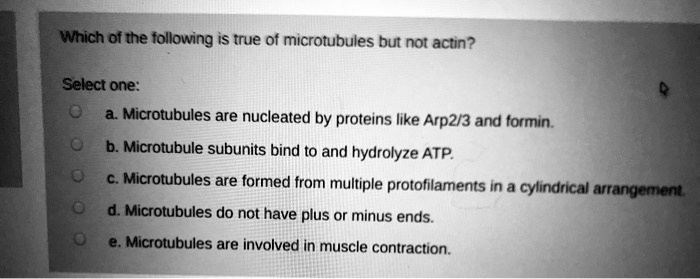Which of the following is true of microtubules but not actin? Select one: Microtubules are nucleated by proteins like Arp2/3 and tormin. Microtubule subunits bind to and hydrolyze ATP. Microtubules are formed from multiple protofilaments in a cylindrical arrangement. Microtubules do not have plus or minus ends. Microtubules are involved in muscle contraction.

The Correct Answer and Explanation is:
The correct answer is: Microtubules are formed from multiple protofilaments in a cylindrical arrangement.
Explanation: Microtubules and actin filaments are both key components of the eukaryotic cytoskeleton, but they differ significantly in structure, function, and molecular composition.
Microtubules are hollow tubes composed of α- and β-tubulin heterodimers. These dimers polymerize into linear chains known as protofilaments. Typically, thirteen protofilaments associate side-by-side to form a cylindrical tube. This highly ordered, symmetrical arrangement provides microtubules with the rigidity and structural integrity required for their cellular roles, such as vesicle transport, mitotic spindle formation, and organelle positioning.
Actin filaments, by contrast, are composed of globular actin subunits that assemble into a helical polymer. They do not form cylindrical structures. Instead, actin filaments are thinner and more flexible, playing major roles in cell shape, motility, and processes like endocytosis and cytokinesis.
The other answer choices are incorrect for the following reasons:
- Arp2/3 and formin are nucleation proteins associated with actin filaments, not microtubules. Microtubule nucleation is primarily mediated by the γ-tubulin ring complex.
- Microtubule subunits bind to and hydrolyze GTP, not ATP. This GTP hydrolysis is important for dynamic instability, a hallmark of microtubule behavior.
- Microtubules possess structural polarity, having distinct plus and minus ends. This polarity is critical for directional motor protein movement and intracellular transport.
- Muscle contraction is primarily driven by interactions between actin filaments and myosin motors. Microtubules are not involved in generating contractile force in muscle cells.
Recognizing the cylindrical arrangement of protofilaments as unique to microtubules helps distinguish them structurally from actin filaments, reinforcing their specialized roles within the cell
